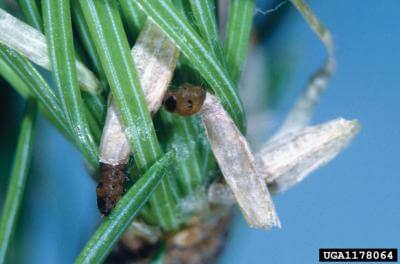
NOTE: this pest is not known to spread in or on firewood. It is included in the Gallery of Pests for general information purposes only.
Larch casebearer is a moth that feeds on larch species (Larix) and was probably introduced in Massachusetts on nursery stock from Europe in 1886 (Tunnock & Ryan, 1983; Otvos & Quedau, 1984). The pest spread throughout the range of tamarack (L. laricina), reaching the Great Lakes region in the 1950s and southeastern Manitoba by 1970 (Otvos & Quednau, 1984). An infestation was found on western larch (L. occidentalis) in Idaho in 1957 (Denton, 1979). In western forests, the insect spread rapidly and was soon considered to be the western larch’s most serious pest (Denton, 1979). The insect feeds on the internal tissue of tree needles, causing defoliation. Repeated defoliations can kill the tree or stunt it by reducing potential growth by as much as 97% (Tunnock et al., 1969). The larch casebearer favors younger trees growing in the open or along forest edges (Tunnock & Ryan, 1983).
Control of this pest has relied upon environmental factors and parasitoids, both naturally occurring and introduced. Prolonged cold, wet springs with frosts will cause insect mortality. There is an abundance of natural predators and parasitoids of the larch casebearer, but they are not efficient enough to stop outbreaks. Fortunately, a combination of naturally occurring predators and parasitoids and introduced parasitoids has been successful in eastern and central Canada and the northwestern U.S. (Otvos & Quednau, 1984; Graham, 1949; Ryan et al., 1987). Two introduced European parasitoids, Agathis pumila and Chrysocharis laricinellae, have been able to aid in keeping the pest under control in western forests where it causes the most serious damage (Tunnock & Ryan, 1995; Ryan, 1997).
USFS scientists and managers developed a conservation priority-setting framework for forest tree species at risk from pest & pathogens and other threats. The Project CAPTURE (Conservation Assessment and Prioritization of Forest Trees Under Risk of Extirpation) uses FIA data and expert opinion to group tree species under threat by non-native pests into vulnerability classes and specify appropriate management and conservation strategies. The scientists prioritized 419 tree species native to the North American continent. The analysis identified 15 taxonomic groups requiring the most immediate conservation intervention because of the tree species’ exposure to an extrinsic threat, their sensitivity to the threat, and their ability to adapt to it. Each of these 15 most vulnerable species, and several additional species, should be the focus of both a comprehensive gene conservation program and a genetic resistance screening and development effort. Larch Casebearer is not known to be a threat to any of these 15 most vulnerable species.
Sources
Denton, R. E. 1979. Larch casebearer in western larch forest. United States Department of Agriculture, For. Serv. Gen. Tech. Rep. INT-55. 62 pages.
Graham, A. R. 1949. Developments in the control of the larch casebearer, Coleophora laricella (Hbn.). In 79th Ann. Rep. Entomological Soc. Ontario (1948). pp. 45-50.
Otvos, I. S. and F. W. Quednau. 1984. Coleophora laricella (Hubner), Larch Casebearer (Lepidoptera: Coleophoridae). In J. S. Kelleher and M. A. Hulme (eds.). Biological Control Programmes against Insects and Weeds in Canada 1969-1980, Commonwealth Agricultural Bureaux, England, 1984.
Potter, K.M., Escanferla, M.E., Jetton, R.M., Man, G., Crane, B.S., Prioritizing the conservation needs of US tree spp: Evaluating vulnerability to forest insect and disease threats, Global Ecology and Conservation (2019), doi: https://doi.org/10.1016/
Ryan, R. B., S. Tunnock, and F. W. Ebel. 1987. The larch casebearer in North American. J. For. 85: 33-39.
Ryan, R. B. 1997. Before and after evaluation of biological control of the larch casebearer (Lepidoptera: Coleophoridae) in the Blue Mountains of Oregon and Washington, 1912-1995. Environ. Entomol. 26: 703-715.
Tunnock, S., R. E. Denton, C. E. Carlson and W. W. Janssen. 1969. Larch casebearer and other factors involved with deterioration of western larch stands in northern Idaho. United States Department of Agriculture, Forest Serv. Res. Pap. INT-68. 10 pp.
Tunnock, S. and R. B. Ryan. 1983. “Larch Casebearer in the Western Larch.” United States Department of Agriculture, Forest Service. Forest Insect and Disease Leaflet 96, Revised September 1983.
Tunnock, S. and R. B. Ryan. 1995. Larch casebearer in western larch. USDA Forest Service, Forest Insect & Disease Leaflet no. 96. 2 pp.



